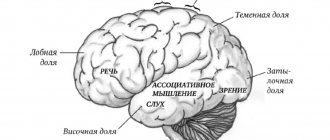All thoughts, plans and actions of a person are in one way or another determined by his picture of the world. Each of us perceives what is happening around us in our own way, based on our own experience and characteristics of thinking. Therefore, the opinions of two different people about the same event can be diametrical. It is worth understanding what perception is and why so much depends on it.
Perception - what is it?
This term is defined by psychology, since the results of mental activity are in its field of study. Perception, or perception, is a concept that denotes the process of a person’s formation of a holistic image of a certain object or phenomenon, as a result of its direct influence on the senses, followed by analysis of the data obtained. It is the most important tool for understanding the surrounding reality and adapting to it.
For example, when meeting an apricot for the first time, a person, having completed its visual perception, will try what it feels like to the touch, evaluate its weight, shape, taste, and get a complete picture of it. Having information about its benefits and chemical composition, having analyzed the experience gained in getting to know this fruit, it becomes possible to create a ready-made, full-fledged image of it. In the future, this facilitates the processes of recognition, comparison and evaluation of objects with an already formed understanding of what they should be.
Sense system
Any irritation is recorded by the nervous system thanks to the sensory organs (eyes, ears, olfactory and gustatory organs) and special endings (receptors) located in the skin, internal organs, skeletal muscles, joints. Sense organs are anatomical formations that perceive external influences and transmit a signal to the central nervous system as an impulse. They are able to accept external stimuli of different nature, thanks to which a person forms a complete picture of the world and can navigate in it.
Feelings make it possible to receive and analyze information from the outside. Vision, smell and hearing ensure its reception at a distance, taste buds and touch - through direct contact. If a person does not have the ability to perceive the environment with any of the types of senses, then others become aggravated to help the body. For example, it is known that people who have lost their sight begin to hear better. Understanding information received from the outside world and from one’s own body is an important factor in human existence.
Sensation is an individual sensory reaction of the body to an irritating factor. They are provided by the sense of touch, smell, taste organs, and the presence of visual and auditory functions. A person is able to feel heat and cold, pain, vibration, feel the position of the limbs, and the distribution of muscle load. Thanks to the presence of sensations, sensory perception is possible - their analysis and the ability to convey them in words.
Contact sensitivity is the reception of information about a stimulus as a result of direct contact of the human body with the object. This includes touch, pain, reaction to ambient temperature, etc. With the help of the taste organs, a person is able to feel the taste of food: salty, spicy, sweet, etc. With the help of vision, light and surrounding objects at a distance are perceived. Hearing focuses attention on sounds, smell - on smells.
The difference between perception and sensation
For a deep understanding of mental processes, it is important to understand the terms and their relationships. Sensation and perception are often confused, but now it will become clear that they are not the same thing at all:
- Information received from one sense organ is a sensation. Perception includes experience gained from several analyzers.
- The sensation gives rise to some kind of feeling - heaviness, sweetness, coldness. Perception ends with the formation of a holistic image.
- Thanks to sensations, we assimilate individual characteristics of objects and phenomena. Perception paints a complete picture of them in our minds.
- All living organisms have sensations, that is, the ability to perceive objects through receptors. The development of perception is accessible only to creatures with a complex nervous system and perceptual psyche.
- As a conclusion, perception is carried out by receiving all possible sensations from contact with an object or phenomenon, but is not reduced to their sum. To be considered perceived, the information received must still be analyzed and compiled into a single representation - an image.
Properties of perception in psychology
Studying their characteristics helps to better understand concepts. In psychology it is generally accepted that the properties of perception are:
- Objectivity
. The totality of sensations we receive does not exist chaotically in space, but is tied by our consciousness to specific objects of the external world. - Integrity and structure
. The individual characteristics of an already perceived object are structurally connected with each other so strongly that even after interacting with one of them, a complete image of the object emerges in the mind. - Consistency
. Once perceived, an object retains its characteristics in our consciousness, even if we subsequently observe it in a distorted form. - Meaningfulness
. What is perception without thinking involved? Just a set of receptor reactions to external stimuli. It is possible to classify an object and form a basic understanding of its properties only by applying analytical skills and existing experience. - Selectivity
. The human psyche cannot cope with simultaneously qualitatively perceiving several objects, therefore, when we carefully look at something new and interesting, the rest of the world seems to cease to exist for a while.
Principles of perception
Once you see optical illusions, you are no longer sure how accurately your brain processes information about the surrounding reality. It is easy to explain the success of such tricks if you know the long-studied principles or laws of perception:
- Grouping
. The mind continuously strives to establish correlations between perceived objects. It automatically classifies objects located nearby, moving in the same direction, or similar in shape or other characteristics to one group and links them into one class. - Isolating background and figure
. If attention is directed to a specific object, then everything that surrounds it is perceived by the brain as a background. As soon as you shift your focus to something else, the recent object of knowledge will instantly merge with the background environment. - Completion
. This principle manifests itself in the fact that our consciousness strives to complement the missing fragments in the perceived object in order to obtain a complete image.
Channels of perception
Data about the world around us continuously enters our consciousness. They are captured and delivered to the necessary parts of the brain, passing through the following channels of information perception:
- Visual
. Everything that we perceive with our visual organs is visual information. - Auditory
. Data perceived by ear, that is, all the sounds around us. - Kinesthetic
. This channel combines sensations such as taste, smell, touch, meta-sensations (our internal reactions and emotions from interaction with external objects).
Human nervous system
The nervous system (NS) includes the central (CNS) and peripheral. The central nervous system controls the functioning of the brain and spinal cord. Peripheral – these are nerve fibers emanating from the brain and located throughout the body. Thanks to them, the brain has a connection with the sensory system and with the executive organs (muscles, endocrine glands).
The nervous system is responsible for performing an important function - making a sensory analysis of the surrounding world in order to adapt to it. The cerebral cortex includes several parts that have their own specific functions. Thus, the occipital region is responsible for visual perception, the frontotemporal region performs speech function, and the temporal region performs auditory function.
Perception factors
Why do people who have the same channels of perception and information processing mechanisms see the same reality so differently? Differences and features of perception are caused by external and internal factors that affect our ability to understand the world. External ones include:
- Repeatability
: images of frequently encountered objects are formed in the mind more complete. - Intensity of influence
: a strong effect on receptors or provocation of strong emotions is what accelerates perception. - Contrast
: objects or phenomena that stand out from the general mass are better remembered and more readily analyzed by our brain. - Movement
: static and dynamic objects are perceived differently, and to get a complete picture of an object, it is advisable to observe it in all states.
What is subjective perception and what internal factors influence it? Three principles have been derived that explain the selectivity of the brain during cognition of reality:
- Resonance
: consists in the fact that phenomena that are in our sphere of interest are perceived more readily than others. - Alertness
: something that threatens personal safety instantly comes into focus, in contrast to neutral objects. - Defenses
: the brain protects its beliefs, therefore it resists the perception of any information that contradicts them.
Emotional map of the brain: where do our feelings live?
How are emotions, feelings - and our brain connected? Does this happen in the same way in the brains of men and women? We will try to create an “emotional brain map” to understand how we feel, why anger is similar to happiness and why a person cannot live without gentle touch.
Guilt and Shame: Temporal Lobes
It’s easy for us to understand how memory or counting can be processes occurring in the brain. However, feelings aren't quite so simple, partly because in speech we use phrases like "break your heart" to describe sadness or "blush" to describe shame. And yet, feelings are a phenomenon from the field of neurophysiology: a process that takes place in the tissues of the main organ of our nervous system. Today we can partially appreciate it thanks to neuroimaging technology.
As part of their research, Petra Michl and several of her colleagues at the Ludwig Maximilian University in Munich recently took a series of MRI scans. They sought to find areas of the brain that are responsible for our ability to feel guilty or ashamed. Scientists have found that shame and guilt seem to be neighbors on the block, although each of these feelings has its own anatomical region.
The researchers asked participants to imagine feeling guilty or ashamed, and in both cases it activated the temporal lobes of the brain. At the same time, shame involved the anterior cingulate cortex, which monitors the external environment and informs a person about mistakes, and the parahippocampal gyrus, which is responsible for remembering scenes from the past. Vina, in turn, “turned on” the lateral occipitotemporal gyrus and the middle temporal gyrus, the center of the vestibular analyzer. In addition, the anterior and middle frontal gyri began to work in shamed people, and in those who felt guilty, the amygdala (tonsils) and insula became more active. The last two areas of the brain are part of the limbic system, which regulates our basic fight-or-flight emotions, the functioning of internal organs, blood pressure and other parameters.
Having compared MRI images of the brains of people of different sexes, scientists found that in women, guilt affected only the temporal lobes, while in men, the frontal lobes, occipital lobes and tonsils began to work in parallel - one of the most ancient elements of the brain, which are responsible for feelings of fear, anger, panic and pleasure.
Fear and Anger: The Amygdala
During intrauterine development of the embryo, the limbic system is formed immediately after the trunk, which organizes reflexes and connects the brain with the spinal cord. Her job is feelings and actions that are necessary for the survival of the species. The tonsils are an important element of the limbic system. These areas are located near the hypothalamus, inside the temporal lobes, and are activated when we see food, sexual partners, rivals, crying children, and so on. The body's various reactions to fear are also their work: if you feel like a stranger is following you at night in the park and your heart starts pounding, this is due to the activity of the tonsils. In the course of several independent studies conducted at various centers and universities, experts were able to find out that even artificial stimulation of these areas causes a person to feel that imminent danger is approaching.
Anger is also largely a function of the amygdala. However, it is very different from fear, sadness and other negative emotions. The amazing thing about human anger is that it is similar to happiness: like joy and pleasure, it makes us move forward, while fear or grief forces us to withdraw. Like other emotions, anger, malice and rage cover a variety of parts of the brain: after all, in order to realize their impulse, this organ needs to assess the situation, access memory and experience, regulate the production of hormones in the body and do much more.
Tenderness and comfort: somatosensory cortex
In many cultures, it is customary to hide sadness and shock: for example, in British English there is even an idiomatic expression “keep a stiff upper lip,” which means “not to show your feelings.” However, neuroscientists argue that from the point of view of brain physiology, a person simply needs the participation of other people. “Clinical experiments show that loneliness provokes stress more than any other factor,” says German scientist, author of the book “The Science of Happiness” Stefan Klein. “Loneliness is a burden on the brain and body. The result is anxiety, confusion in thoughts and feelings (a consequence of stress hormones) and a weakened immune system. Isolation makes people sad and sick.”
Study after study shows that companionship is good for you physically and mentally. It prolongs life and improves its quality. “One touch from someone close to you and deserving of your trust eases sadness,” says Stefan. "This is a consequence of the neurotransmitters - oxytocin and opioids - that are released during moments of tenderness."
Recently, British researchers were able to confirm the theory of the usefulness of affection using computed tomography. They found that the touch of other people causes strong bursts of activity in the somatosensory cortex, which is already working constantly, tracking all our tactile sensations. Scientists have come to the conclusion that the impulses that arise if someone gently touches our body in difficult moments are associated with the process of isolating from the general flow of critical stimuli that can change everything for us. Experts also noticed that the experiment participants experienced grief more easily when a stranger held their hand, and much easier when their palm was touched by a loved one.
Joy and laughter: prefrontal cortex and hippocampus
When we experience joy, experience happiness, laugh or smile, many different areas of our brain light up. The process of creating and processing positive emotions involves the familiar amygdala, prefrontal cortex, hippocampus, and anterior insula cortex, so that feelings of joy, like anger, sadness, or fear, pervade the entire brain.
In joyful moments, the right amygdala becomes much more active than the left. Today, it is widely believed that the left hemisphere of our brain is responsible for logic, and the right hemisphere for creativity. However, we have recently learned that this is not the case. The brain requires both parts to perform most functions, although hemispheric asymmetries exist: for example, the largest speech centers are located on the left, while processing of intonation and accents is more localized on the right.
The prefrontal cortex is several areas of the brain's frontal lobes that are located at the front of the hemispheres, just behind the frontal bone. They are associated with the limbic system and are responsible for our ability to set our goals, make plans, achieve desired results, change course and improvise. Research shows that during happy moments in women, the prefrontal cortex on the left hemisphere is more active than the same area on the right.
The hippocampi, which are located deep in the temporal lobes, together with the amygdala, help us separate important emotional events from unimportant ones so that the former can be stored in long-term memory and the latter can be discarded. In other words, the hippocampi evaluate happy events in terms of their significance for the archive. The anterior insula cortex helps them do this. It is also connected to the limbic system and is most active when a person remembers pleasant or sad events.
Lust and love: not emotions
Today, the human brain is studied by thousands of neuroscientists around the world. However, science has not yet been able to accurately determine what emotion and feeling are. We know that many feelings originate in the limbic system, one of the most ancient elements of the brain. However, perhaps not everything we have traditionally recognized as an emotion actually is. For example, lust from the point of view of brain physiology is not similar to fear or joy. Its impulses are formed not in the tonsils, but in the ventral striatum, which is also called the “reward center.” This area is also activated during orgasm or eating tasty food. Some scientists even doubt that lust is a feeling.
However, lust differs from love, which activates the dorsal striatum. It is curious that the brain uses the same area if a person uses drugs and becomes dependent on them. However, we definitely experience happiness, fear, anger and sadness more often during periods of love than during calm periods - which means that love should perhaps be considered the sum of emotions, desires and impulses.
Icons: Pham Thi Dieu Linh
Types of perception
In addition to external and internal factors, the process of cognition is also influenced by individual characteristics of the psyche. Based on this, the following types of perception in psychology are distinguished:
- synthetic type;
- analytical type;
- analytical-synthetic type.
Synthetic type of perception
Perception in psychology is divided into types depending on the specificity of the human senses’ coverage of the characteristics of the object being studied. Synthetic perception is characterized by little attention to detail, but a clear awareness of the overall picture, an understanding of the main essence of events. People who are prone to this type of perception do not tend to delve into the subtleties of everything that happens; they are content with a generalized vision.
Analytical type of perception
Synthetic perception, as an extreme, also has its antipode. The analytical type is just such a perception in psychology that is characterized by excessive attention to detail, the opposite of generalization. Having a penchant for it, it can be difficult to grasp and analyze the general idea of the events taking place, but not a single detail of the surrounding reality will be left unattended.
Analytical-synthetic type of perception
Just as there are no pure types of temperament, so types of perception are rarely found in such a refined, one-sided form. The classification of perception is very arbitrary, because each of us has inclinations towards both of the above types, except that one of them may predominate. Trying to analyze the particular, we strive to create a general picture, and having received a general idea, we break it into fragments for a more complete understanding.
Why are there five senses and some are “better” than others?
Everyone is taught that “a person has five senses” in preschool age. This is considered an immutable truth, and when they say “sixth sense,” they mean either intuition or some kind of paranormal ability - as in the film of the same name, the boy who “saw dead people.” However, how did it happen that a person has exactly five senses? The foundations of the study of sensory perception, like many other concepts, have their origins in Ancient Greece.
According to Plato, feelings are associated with the elements. The higher the gods, when constructing people, placed certain parts of the body, the more “divine and holy” they are.
The most divine thing in the world is the Good, good as such, and Plato likens it to the Sun. Human eyes contain a kind of inner fire that can emanate outward. The merging of this “visual outflow” with the light coming from outside creates the visual ability. Vision is associated with light, and therefore with the element of fire.
Hearing is related to the element of air. This also has a deep metaphysical meaning, because sound, like the ability to speak, was created to participate in the harmony of the spheres, “the paths of which are akin to the rotations of the soul.” Odors are considered transition states in which water turns into air (or vice versa). The sense of taste is caused by tiny particles of a substance that affect the tongue in one way or another. In the same way, tactile sensations are obtained - for example, fire burns because its particles are small, sharp and move quickly, but water particles, on the contrary, are round.
Aristotle distinguished three types of soul - plant, animal and human. Each of them had its own set of ways to comprehend the world.
“Vegetative abilities” associated with reproduction and nutrition are found in all living things. In animals they are joined by the following, more developed “floors” of perception. Above all is the man who possesses not only all the senses, but also the faculty of reasoning and imagination.
Thanks to Plato and Aristotle, a hierarchy of senses arose in which sight and hearing were higher and nobler than the lower senses of taste, smell and touch. The sense of touch, according to philosophers, is inherent even in worms, while vision and hearing are in connection with the divine supersensible order. It is this traditional set of five senses, which are also arranged hierarchically, that has come to be considered the basic set of human perception.
Subsequently (and until the last two centuries), Western scientists tended to believe that the more highly developed and spiritual a subject is, the more he is involved in noble feelings.
Less developed peoples and representatives of the lower classes, the science of that time assured, corresponded to simple and crude types of cognitive abilities. Hence, for example, comes the idea that savages living somewhere in mangrove forests have a sensitive, almost animalistic sense of smell.
The opinion that the sensory system of representatives of the indigenous population of certain parts of the planet is qualitatively different from the sensory system of a European has long existed in science. Natural philosophers and ethnographers believed in deep natural differences between natives and Westerners. At the same time, they considered themselves the bearers of the most intellectual sense - vision.
This also affected the way science looked at ancient people - and even the developed Hellenic civilization got it. It is widely known that the same Greeks had rather unusual ideas about colors for us. Homer’s sea is “wine-colored” and the skies are copper, so some researchers have put forward the idea that ancient people did not see the color blue at all.
The scientist and politician William Gladstone suggested that the Greeks had a rather poorly developed “organ of color,” so that their world was much dimmer than ours. People's vision, in his opinion, was improved in the same way as it is trained by artists.
This is how a big scientific dispute arose - the controversy about the naming of flowers. Gladstone's approach fit well with Darwin's theory, which had gained enormous popularity at that time. German physician Hugo Magnus put forward an even bolder idea: perhaps vision continues to evolve, the visible spectrum is expanding, and in the future people will be able to see in ultraviolet light.
At the same time, other scientists doubted that such changes could occur so quickly, and noted that even insects have color vision, so it is unlikely that the ancient Hellenes did worse than some butterflies. The English researcher Grant Allen believed that people are anthropologically much more similar than it seems to Gladstone and his followers, so the sensory characteristics of representatives of the same species are the same. And there was no blue in Greek culture for so long because of the difficulty of obtaining blue dye.
Ethnographic studies show that the differences at the level of thinking and language can indeed be enormous - despite the fact that human receptors do not differ much from one society to another.
It is much more important what significance certain sense organs have in each specific culture. People are able to ignore certain sensory signals or, on the contrary, bring them to the fore, making them key to their society and understanding of the world.
Levels of perception
The process of cognition of an object takes place in several stages. The structure of perception is due to several levels of information processing in our brain. There are four in total:
- Detection
. At this stage, only the fact of irritation of receptors during interaction with an object is recorded by consciousness. - Discrimination
. Now the brain receives signals from analyzers about what qualities the perceived object has. - Identification
. Having received information about the properties of an object, consciousness correlates them with the properties of other objects, the images of which are stored in its memory. - Identification
. Having analyzed its past experience and new data, the brain assigns a new object to the groups and categories at its disposal. Recognition and classification of an object means that such perception was successful.
How does the human body react to external irritation?
The main mechanism of action of the NS is a reflex, which is the body’s response to irritation. Reflexes are conditioned and unconditioned (innate). Conditioned reflexes are developed during life at those moments when the human body adapts to environmental conditions, so they can change and, as a rule, are short-term in nature.
All changes occurring in the world are recorded by special sensitive cells called receptors and converted into nerve impulses. An impulse is a series of electrical and chemical changes that occur in a nerve fiber. Such an impulse is sent to the brain. The latter analyzes the received signal, sending command impulses to the executive bodies, including response actions.
The brain belongs to the central nervous system and is located inside the skull. It consists of the cerebrum and medulla oblongata, cerebellum, and trunk. The spinal cord is located inside the spinal column.
Errors of perception
Our cognitive abilities are not perfect and are often influenced by various factors. Behavioral psychologists have experimentally identified several of the most common perceptual errors:
- Halo effect
. It consists in the fact that our already formed attitude towards some quality of an object or person determines the attitude towards it as a whole, even if its other characteristics would cause completely different emotions. - The effect of prejudice
. This disturbance of perception manifests itself in the selective blindness of our consciousness regarding the information that can destroy already established stereotypes. - Availability effect
. If examples of certain phenomena easily come to mind, then we automatically consider them common, even if statistics say otherwise. - Projection effect
. We readily attribute our own characteristics to other people. Such perceptual effects often lead to disappointment.
Hearing organs
The organ of hearing is the ears, with the help of which we recognize different sounds and can approximately determine their range and strength. Sounds travel through waves. There are certain limits. If the sound goes beyond these limits, it is called ultrasound or infrasound. The hearing organs need to be protected. There are simple rules for this:
- You cannot listen to loud music, especially with headphones;
- It is forbidden for anyone to yell loudly in the ear;
- You can only clean your ears with cotton swabs; do not use sharp objects, otherwise you can damage the eardrum;
- You need to clean and wash your ears every day;
- In case of any illness or discomfort, consult a doctor immediately.
Illusions of perception
Sometimes, when various sensations accumulate, some of them may become distorted in our consciousness under the influence of others. Such illusions of perception in psychology are not considered something negative; rather, on the contrary, they are explainable effects in which patterns can be found. Distortions can occur in any sense organs and are, for example:
- Optical
. The organs of vision are easy to deceive; they succumb to illusions from the refraction of sunlight, make mistakes in perceiving the size of objects depending on their surroundings, and can perceive the same color differently, but against different backgrounds. - Flavoring
. Sweet fructose imparts bitterness to neutral-tasting water, which is explained by the unexpected effect of such a tandem on the receptors. - Proprioceptive
. These are illusions of perception of reality by the muscular system: for example, when transport suddenly stops, our body continues to feel it moving.
Theories of perception
In the scientific community, discussions have continued for many decades about the mechanisms that ensure the reflection of objective reality in human consciousness. There are several theories that describe this process in their own way:
- Structuralism
. The original theory that reduces perception to the sum of sensations received from an object and comparison with previously gained experience. - Gestalt theory
. He criticizes structuralism, arguing that perception is a more complex process, since not only private sensations form an image, but also the formed image influences the received sensations.
Person's perception by person
In addition to knowledge of surrounding objects and phenomena, it is important for people, as social beings, to be able to form an impression about others. Interpersonal perception is much more complex and complex than the perception of inanimate objects. Initially, the idea is formed based on visual data, by analyzing the details of appearance: neatness, style, characteristic facial features and physique, which are compared with existing stereotypes.
Later, in the process of communication, it becomes obvious that such superficial perceptions are not reliable. It is supplemented with information about belonging to a social group (with the transfer of all the stereotypical qualities of representatives of this group to a new acquaintance), interests, abilities and character. Sensitivity to the emotional states of your interlocutor will also help to make his image more complete and interact with him more effectively.











